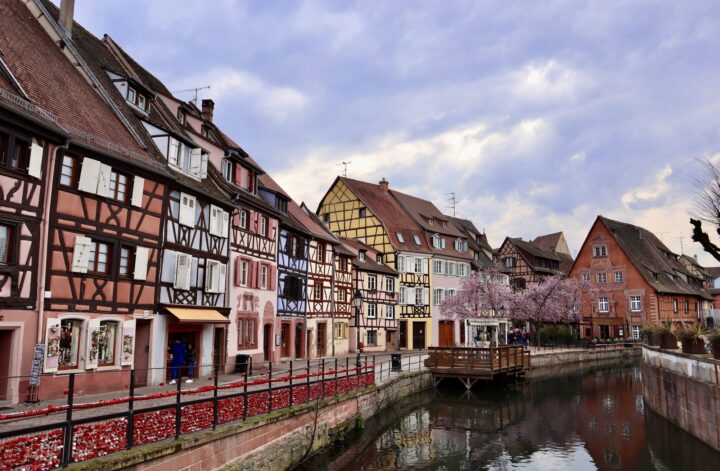Colmar is located in Alsace and is one of the most picturesque and enchanting destinations in France.
Medieval narrow streets, colourful buildings and serene canals make up the backdrop of a fairytale place that looks like it came straight from a postcard.
Alsace is known for its rich history, its unique blend of traditional German and French culture, and its enchanting towns and villages.
Located in northern France near the German border, this region has passed several times from French to German rule, which has given it a distinct identity with influences from both cultures.


The villages and towns belonging to Alsace
Alsace is known for its picturesque villages and idyllic towns, and Colmar is its centre.
Apart from Colmar, Alsace is home to other beautiful towns and villages, such as Strasbourg, which is the capital of the region and the seat of the European Parliament.
The villages on the “Route des Vins” (Wine Route) are also famous for their traditional houses, vineyards and traditional gastronomy.
Some of the most famous villages worth visiting in Alsace are Eguisheim, which is one of the most beautiful villages in France with its colourful houses, Riquewihr, which seems to be trapped in time, and Kaysersberg, which combines historical charm with stunning views.
Public transportation in Colmar
The nearest airport to Colmar is Strasbourg. You can get to Colmar by car, bus or train from surrounding countries and cities. I arrived in Colmar by train from Luxembourg.
The old town of Colmar can be explored all on foot, and if you want to get around, buses will take you wherever you want.
In fact, there are even buses that will take you to surrounding villages, such as Riquewihr, with several routes throughout the day.
What to see in Colmar
Vieille Ville
The Old Town of Colmar is the perfect place to start your exploration.
Here, you’ll wander down narrow, cobbled streets lined with traditional houses with wooden windows and colourful facades.


The Old Town brings out the atmosphere of the Middle Ages and transports you back in time. Colmar is famous for its architecture and the Old Town is the ultimate place to enjoy it in all its glory.


Collégiale Saint-Martin de Colmar
The Synagogue of Saint-Martin (Collégiale Saint-Martin) is Colmar’s most impressive religious monument and is definitely worth a visit.
Built in the 13th century, this Gothic church impresses with its architecture and refined decoration. Inside, visitors can admire beautifully polished stained glass windows and an impressive altar.


Maison Pfister
The Maison Pfister is one of the most emblematic buildings in Colmar and a typical example of 16th century architecture in the area.
The building is recognised for its colourful wooden windows, decorative carvings and curved lines. It is one of the most photographed spots in the city.

Koïfhus
The Koïfhus, or “Old Bank of Colmar”, was built in the 15th century and is the oldest public building in the city.
Its history is inextricably linked to the trade of Colmar and its importance as a commercial centre during the Middle Ages.

Place de l’Ancienne Douane
Place de l’Ancienne Douane is a magnificent square that combines history and natural beauty.
Here you will find the building of the old Colmar customs office, which was responsible for controlling trade and customs taxes. Today, the square is a spot for relaxation and cafés, surrounded by charming buildings and traditional restaurants.

Quartier des Tanneurs
The Quartier des Tanneurs is the historic “commercial centre” of the city, once home to the cheese makers’ and tanners’ workshops.
Today, it is a quiet and charming place to walk among old buildings with 16th and 17th century settings.

Marché Couvert Colmar
If you love local gastronomy, the Marché Couvert Colmar is the ideal market to discover authentic Alsatian products. From cheeses, charcuterie and local specialities to fresh fruit and vegetables, this market is the perfect place to experience the flavours and aromas of the region.
In addition to local flavours, you’ll find shops serving other cuisines, such as Asian cuisine or pizza shops.


Pont Rue des Tanneurs
The Rue des Tanneurs bridge is one of the most picturesque streets in the city and connects the cheese-making area with the rest of Colmar.
Passing through here, you will cross the Lauch River and have the opportunity to see old houses and restaurants that hide the air of the past.

Pont Rue des Ecoles
The Rue des Ecoles bridge connects the two traditional parts of Colmar and is one of the most characteristic spots to admire the city’s landscape.

Little Venice
Colmar’s Little Venice is one of the most romantic parts of the city, with narrow canals, traditional houses and bridges reminiscent of Italian Venice.
With its vibrantly coloured house facades, flowers and small canals running through it, this area is perfect for a boat ride or just to enjoy the gorgeous views and take perfect photos.

Pont St-Pierre
Another beautiful bridge with stunning view of the wooden houses, next to the canal.

The traditional foods of Alsace
Alsace is famous for its cuisine, with dishes such as choucroute (sauerkraut with sausages and meat) and desserts such as kougelhopf (traditional cake) and tartes flambées (French pies with a creamy base and various ingredients).
In addition, the region is known for its excellent wines, especially Riesling and Gewürztraminer, produced from the vineyards that stretch along the “Wine Route”.
Munster is also one of the most famous cheeses in Alsace. It is an intense, creamy cheese made from cow’s milk and has a distinctive smell.
Finally, Foie Gras (or goose or duck liver pâté) is a popular and sophisticated dish in Alsace, although it is famous throughout France. Alsace foie gras is usually served with bread or fruit, and is a staple of feasts and festive tables.
If you’d like to see more of my trip to Colmar, visit my Instagram profile.




